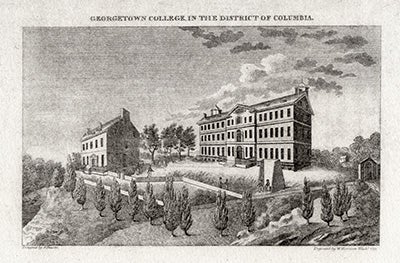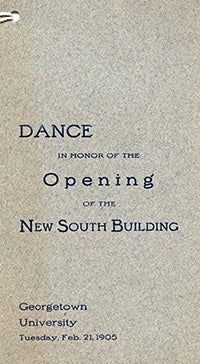
In the early days of Georgetown College, the naming of campus buildings seems to have been a remarkably uncreative activity. Buildings were named for function, like the Infirmary which opened in 1833 (known to us as Gervase) or the Small Boys Building (now known as Maguire) which opened in 1854 to separate the "small" boys or prep students from their older counterparts and the potentially bad influences that they might exert.
And if not named for function, our buildings were named for geographic location. An example is the West Building, or the western wing of the south row, which were both early designations for Isaac Hawkins Hall. The most familiar example of geographic location influencing naming is the North Building, which became "Old" in 1926 when New North opened.
Consideration of our early naming practices seems to naturally raise a question which I get asked far less often than I'd expect: we have an Old North and a New North and we have a New South, so shouldn't there logically be or have been an "Old" South as well?
 The answer is that there was indeed a South Building. In fact, that was one of the names associated with our first building, begun in 1788. This was also known over time as the Carroll Building and the Old College. The South Building was razed in 1904 to make way for Ryan Hall, 54 years before work on New South began--or perhaps I should say on the building we call New South today. Because it appears that when Ryan Hall opened in 1905, consideration was given at least briefly to naming it New South. One lone document in the archives testifies to this: the cover of a dance card from the dance held to celebrate the building's opening on February 21, 1905, which identifies the building as New South. However, likely because the University wanted to recognize the financing of the building by Mrs. Thomas Fortune (Ida) Ryan, four of whose sons attended Georgetown, the New South designation did not stick and the building was named Ryan Hall instead. And so, the New South name was still available for use in the 1950s.
The answer is that there was indeed a South Building. In fact, that was one of the names associated with our first building, begun in 1788. This was also known over time as the Carroll Building and the Old College. The South Building was razed in 1904 to make way for Ryan Hall, 54 years before work on New South began--or perhaps I should say on the building we call New South today. Because it appears that when Ryan Hall opened in 1905, consideration was given at least briefly to naming it New South. One lone document in the archives testifies to this: the cover of a dance card from the dance held to celebrate the building's opening on February 21, 1905, which identifies the building as New South. However, likely because the University wanted to recognize the financing of the building by Mrs. Thomas Fortune (Ida) Ryan, four of whose sons attended Georgetown, the New South designation did not stick and the building was named Ryan Hall instead. And so, the New South name was still available for use in the 1950s.
--Lynn Conway, University Archivist
October 24, 2018
